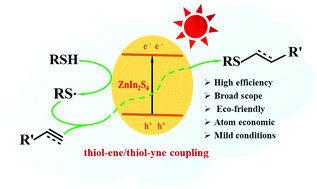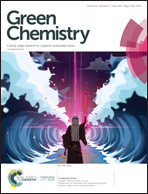Visible light initiated hydrothiolation of alkenes and alkynes over ZnIn2S4†
Abstract
The construction of C–S bonds is very important. The hydrothiolation of alkenes or alkynes with thiols represents an attractive and atom economical approach for the formation of C–S bonds. In this manuscript, flowerlike microspheres of ZnIn2S4 consisting of interweaving nanoflakes were prepared by a solvothermal method and were applied for the first time in the visible light initiated hydrothiolation of alkenes and alkynes. The reactions between a broad range of thiols and alkynes or alkenes over irradiated ZnIn2S4 afford the corresponding hydrothiolated products in moderate to excellent yields. The mechanism proposed based on the ESR results suggests that the holes generated over irradiated ZnIn2S4 are reductively quenched by the thiols to generate thiyl radicals, which are added to the alkynes/alkenes to generate alkene/alkyl radicals for the propagation of thiol–ene/thiol–yne coupling reactions. The use of solar light and a semiconductor-based photocatalyst to realize the thiol–ene and thiol–yne coupling reactions in a green solvent (methanol), with only stoichiometric thiols required and applicable to a broad substrate scope, makes this reaction protocol a green, sustainable and cost-effective strategy for the synthesis of thiolated products. This study also highlights the great potential of semiconductor-based photocatalysis for advanced organic syntheses.



 Please wait while we load your content...
Please wait while we load your content...